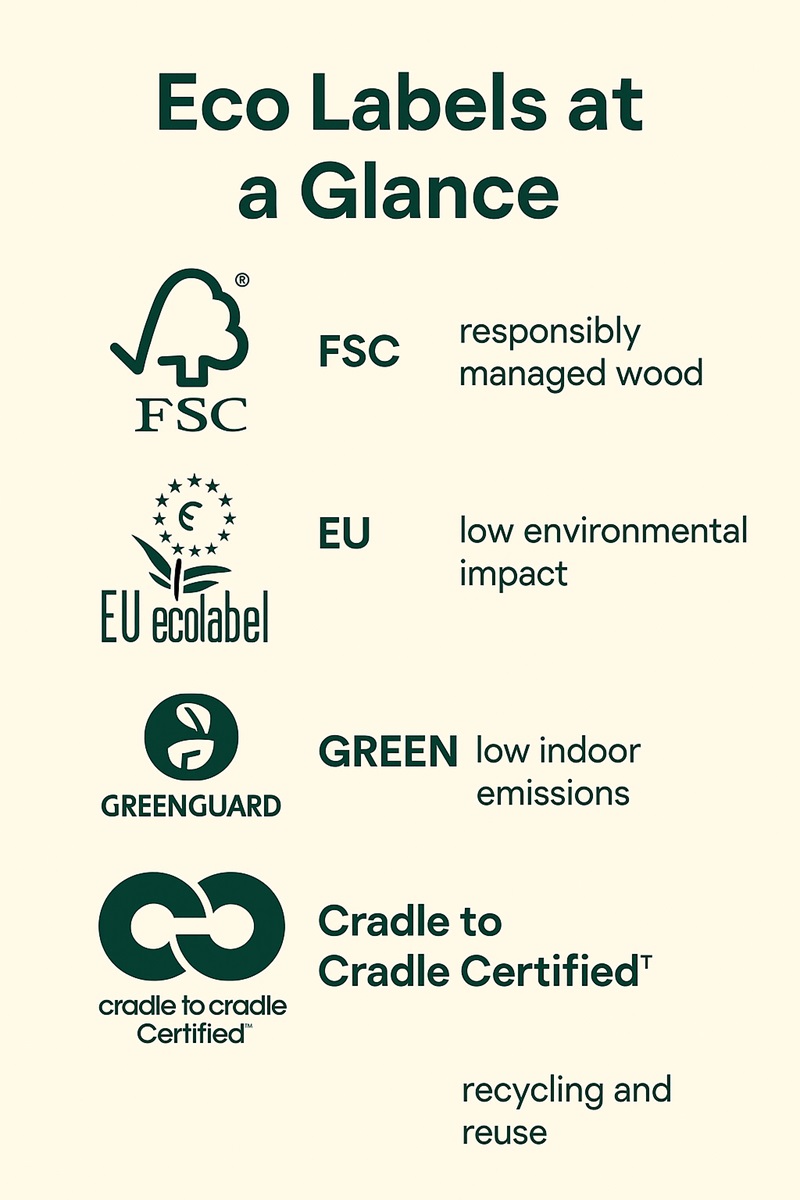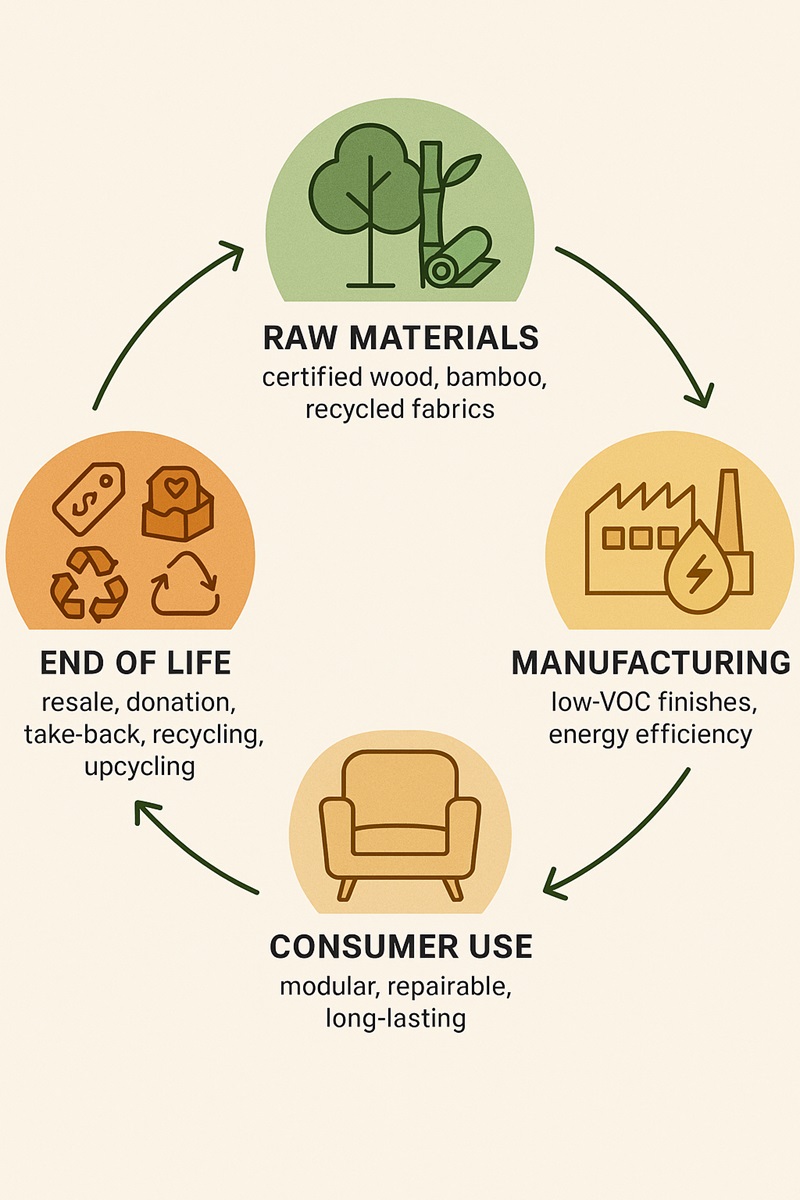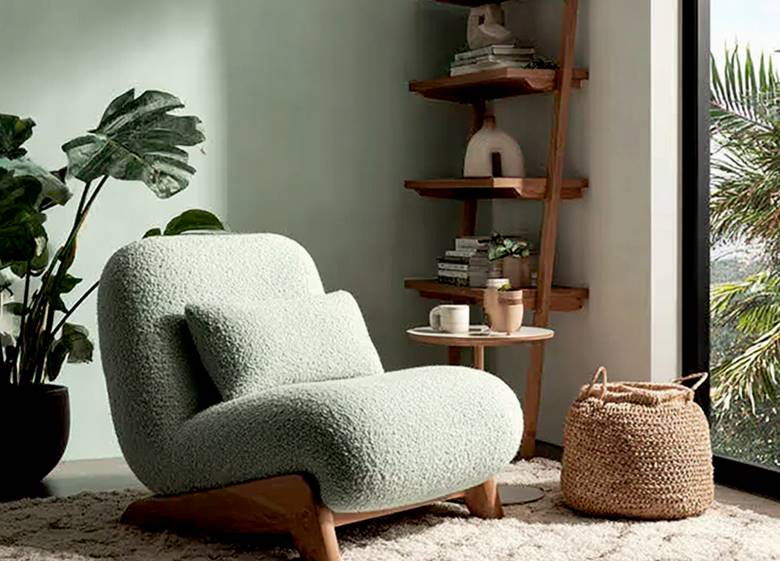The design world has finally started speaking the same language as sustainability. More than ever, furniture makers are opening up about materials, energy use, and sourcing, inviting us to look beyond aesthetics and into what our chairs and tables are really made of. For anyone who wants a beautiful home without compromising the planet, understanding what lies behind those green labels is the first step.
If one buys Cassina or Baxter furniture, there is no need to ask many questions, because they are historically established companies with a recognized commitment to environmental issues. But not everyone knows who to turn to when choosing furniture. So it’s worth clarifying that a nice sofa shouldn’t just be comfortable: it has to be made with traceable materials, recyclable, and safe for the people who make and use it.
From Forest to Frame: The Meaning of FSC and Beyond
The Forest Stewardship Council (FSC) label is one of the most trusted marks on wood furniture. It shows that the wood comes from forests managed with care for nature and local people. If you see “FSC 100%,” all the wood meets these rules. “FSC Mix” means some certified wood is used, while “FSC Recycled” points to reused content.
In Europe, the EU Ecolabel plays a similar role. It checks that furniture is made with safe materials, low emissions, and is easy to recycle. These programs do more than confirm the source. They encourage longer product life and a shift from simple use to reuse.

Sustainable Materials Beyond Wood
Certified wood is still key in eco-friendly furniture, but it’s not the only choice. Other materials also shape a greener home.
Bamboo grows fast, doesn’t need replanting, and is as strong as hardwood while leaving a lighter mark on the planet. Reclaimed wood from barns or old buildings adds history and charm while reducing the need for new logging.
Upholstery matters too. Fabrics made from organic cotton, hemp, or Tencel™ (a fiber from managed forests) cut down on pesticides and heavy water use. Recycled polyester made from plastic bottles offers strength and lowers waste. For cushions, natural latex or plant-based foams can replace petroleum-based materials.
Together, these choices give buyers more options—furniture that looks good, lasts long, and treats the planet with care.
Looking Deeper: Emissions, Fabrics, and Full Life Cycles
Sustainability is not only about wood. Foam, fabrics, glue, and paint can all affect your health and the planet. GREENGUARD marks products with low chemical emissions, making indoor air safer. Cradle to Cradle Certified™ goes even further. It looks at the full product life cycle—materials, energy, water, and even worker impact—before giving a score.
In North America, some office furniture carries the level® mark. This rating checks materials, energy, health, and how products are handled at the end of their use. Together, these systems help you choose furniture that lasts longer, creates less waste, and keeps homes healthier.
The Global View: What Labels Mean Where You Live
Eco-labels change depending on where you live, so knowing the right ones helps cut through confusion.
In North America, GREENGUARD and level® are common. They focus on clean indoor air and full product lifecycles.
In Europe, the EU Ecolabel works alongside FSC. It sets strict rules on recycling and chemical use.
In the Asia-Pacific region, where much furniture is made, programs like Japan’s Eco Mark and Singapore Green Label highlight low emissions and efficient use of resources.
By learning which labels apply in your country, you can compare products with confidence and avoid “greenwashed” claims. Supporting local makers who use reclaimed or low-impact materials also cuts down transport costs and helps the planet.
Reading Labels and Asking Better Questions
Learning to read eco labels is not about memorizing logos. It’s about asking smart questions. Does the label cover the whole product or just part of it? Is it checked by an independent group? Are the rules clear and public?
When shopping, ask simple things: Are fabrics low-VOC? Are finishes water-based? Does the company offer repairs or a take-back program? Real sustainability is open, trackable, and measurable—not just a marketing slogan.
Beyond the Sticker: Longevity as Green Value
A certified piece built to last is far more eco-friendly than a cheap one replaced often. Long life means fewer raw materials, less shipping, and less waste. Many brands now design modular pieces or use recyclable parts so furniture can grow with your home instead of ending up in landfills.
Even small habits make a difference. Caring for what you buy extends its life. Design that adapts is design that respects the future.
Closing the Loop: Repair, Resale, and Recycling
Sustainability does not end when you buy furniture. Many brands now use a circular design approach. They offer take-back programs where old items are collected, taken apart, and reused to make new pieces. Some also create modular furniture, so you can swap or repair parts instead of throwing the whole thing away.
Shoppers play a big part too. Repairing instead of replacing keeps furniture in use longer. Reselling on second-hand markets or donating to reuse centers gives items a second life. Upcycling—like turning a dresser into a bookshelf or a table into a desk—adds creativity while cutting down on waste.
By closing the loop, both brands and buyers help build a circular economy, keeping furniture in use and out of landfills.

Rethinking Luxury and Responsibility
Sustainability is not the end of luxury—it is the new meaning of it. Value is no longer only in looks or price. It also lies in ethics, lifespan, and impact. Certifications tell the story of how a product was made.
When brands share that story, they build trust. When buyers ask for it, they push the industry forward. Design then becomes not just about beauty, but also about awareness.
Buying furniture with trusted labels is a choice for clean air, healthy forests, and fair work. It’s a small step with a big effect. Next time you love a sofa or table, read the fine print. It is not an afterthought—it is part of the design itself. Knowing what we bring into our homes is the first true step to sustainable living.
Furniture’s Carbon Footprint: Why Local Matters
A sofa made from green materials can still have a big carbon footprint if it travels long distances. Shipping heavy furniture across oceans adds a lot of emissions.
Buying from local makers helps cut that impact. It also supports your local economy and makes it easier to check labor and sourcing practices.
Light but strong materials lower shipping energy too. For example, bamboo and aluminum composites give durability without the extra weight.
When choosing furniture, think not just about what it’s made of but also where and how it’s made. Buying closer to home means lower emissions and better oversight.
A Buyer’s Roadmap to Green Choices
If you want to bring sustainability into your furniture shopping, here’s a simple guide:
- Check labels – Look for FSC, GREENGUARD, or EU Ecolabel depending on your region.
- Pick better materials – Choose bamboo, reclaimed wood, organic fabrics, or plant-based foams.
- Ask about finishes – Go for low-VOC paints and water-based coatings.
- Think about the product’s life – Pick modular or repairable designs. Ask if the brand has take-back programs.
- Buy local – Shopping close to home cuts shipping emissions and supports local jobs.
- Go second-hand – Vintage and refurbished furniture is often the most eco-friendly choice.
By following these steps, buyers move from awareness to action. Each choice supports cleaner homes, healthier forests, and fairer supply chains.




